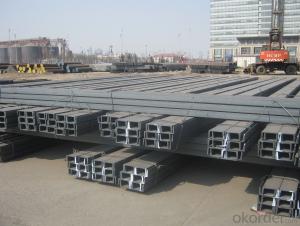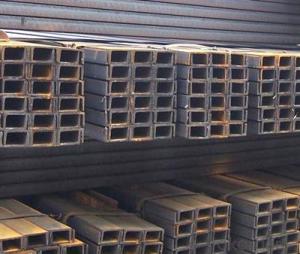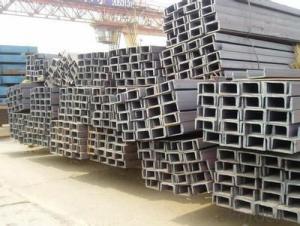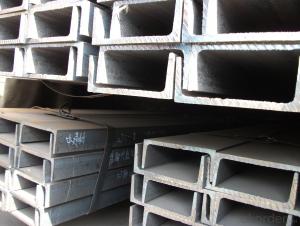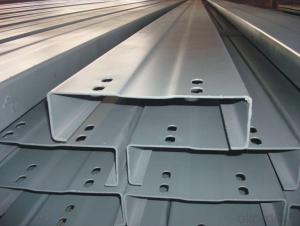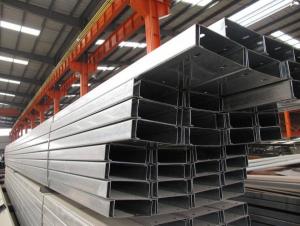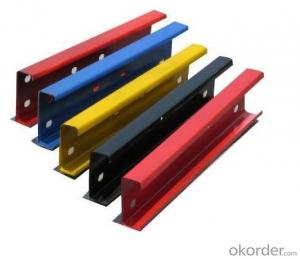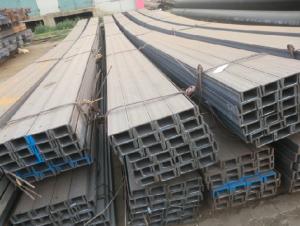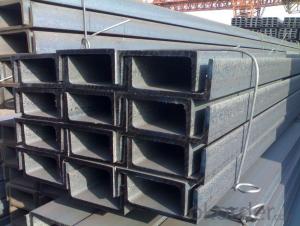Hot Rolled JIS GB Standard Steel Channel
- Loading Port:
- China Main Port
- Payment Terms:
- TT or LC
- Min Order Qty:
- -
- Supply Capability:
- -
OKorder Service Pledge
OKorder Financial Service
You Might Also Like
Product Description:
OKorder is offering STEEL CHANNEL at great prices with worldwide shipping. Our supplier is a world-class manufacturer of steel, with our products utilized the world over. OKorder annually supplies products to European, North American and Asian markets. We provide quotations within 24 hours of receiving an inquiry and guarantee competitive prices.
Product Applications:
1.The JIS channel can be devided into two kinds, namely common channel steel and light channel steel. The sizes of hot rolled common channel steel range from 5# to 40#. Meanwhile, the channel steel can be divided into cold forming sectional equal channel steel, cold forming sectional unequal channel steel, cold forming inner edge channel steel and outer edge channel steel.
2.The JIS channel is usually used for arch-itechtural structure, and they could be welded in order to support or hang a vari-ety of facilities. They are also usually used in combination with I beam. The channel steel with sizes under 14# is usually applied to construction engineering, as purline, while the channel steel with sizes above 16# is more likely to be used in building vehicle chassis structure and mechanical structure. Furthermore, the channel steel in sizes above 30# are target at building bridge structure, as tension bar.
3.In a word, the channel steel must possess perfect welding property, riveting property and mechanical property and so on.
Product Advantages:
OKorder's STEEL CHANNELare durable, strong, and resist corrosion.
Main Product Features:
· Premium quality
· Prompt delivery & seaworthy packing (30 days after receiving deposit)
· Corrosion resistance
· Can be recycled and reused
· Mill test certification
· Professional Service
· Competitive pricing
Product Specifications:
Standard | GB/JIS |
Material Grade | Q235,SS400 |
Technique: | Hot Rolled |
Sizes as per chinese standard: | 50*37*4.5mm - 300*89*11.5mm |
Sizes as per japanese standard: | 50*25*3mm – 200*80*7.5mm |
Length: | 6meter, 9meter, 12meter |
Note: 1.we are also competent to provide our customers other MS Channel based on other sizes according to customer’s requirements.
2. The length of our ms channel could be cut into other meters as per customer’s requirements. For example, the channel in 6meters could be cut into 5.8meters in order to be fit in the 20ft container.
2. The detailed sections of MS Channel as per GB standard.are shown in the table-1:
GB U CHANNEL | Standard | Sectional | Dimension |
| Mass: |
| (mm) | (mm) | (mm) | (mm) |
|
50X37 | 50 | 37 | 4.50 | 7.0 | 5.438 |
63X40 | 63 | 40 | 4.80 | 7.5 | 6.634 |
80x43 | 80 | 43 | 5.00 | 8.0 | 8.045 |
|
|
|
|
|
|
100x48 | 100 | 48 | 5.30 | 8.5 | 10.007 |
120x53 | 120 | 53 | 5.50 | 9.0 | 12.059 |
140x58 | 140 | 58 | 6.00 | 9.5 | 14.535 |
140x60 | 140 | 60 | 8.00 | 9.5 | 16.733 |
|
|
|
|
|
|
160x63 | 160 | 63 | 6.50 | 10.0 | 17.240 |
160x65 | 160 | 65 | 8.50 | 10.0 | 19.752 |
|
|
|
|
|
|
180x68 | 180 | 68 | 7.00 | 10.5 | 20.174 |
180x70 | 180 | 70 | 9.00 | 10.5 | 23.000 |
|
|
|
|
|
|
200x73 | 200 | 73 | 7.00 | 11.0 | 22.637 |
200x75 | 200 | 75 | 9.00 | 11.0 | 25.777 |
|
|
|
|
|
|
220x77 | 220 | 77 | 7.00 | 11.5 | 24.999 |
220x79 | 220 | 79 | 9.00 | 11.5 | 28.453 |
|
|
|
|
|
|
250x78 | 250 | 78 | 7.00 | 12.0 | 27.410 |
250x80 | 250 | 80 | 9.00 | 12.0 | 31.335 |
250x82 | 250 | 82 | 11.00 | 12.0 | 35.260 |
|
|
|
|
| |
280x82 | 280 | 82 | 7.50 | 12.5 | 31.427 |
280x84 | 280 | 84 | 9.50 | 12.5 | 35.823 |
280x86 | 280 | 86 | 11.50 | 12.5 | 40.219 |
|
|
|
|
|
|
300x85 | 300 | 85 | 7.50 | 13.5 | 34.463 |
300x87 | 300 | 87 | 9.50 | 13.5 | 39.173 |
300x89 | 300 | 89 | 11.50 | 13.5 | 43.883 |
Note: we are able to present our customers relevant SGS test report for mechanical property of MS Channel as customer’s request.
FAQ:
Q1: Why buy Materials & Equipment from OKorder.com?
A1: All products offered byOKorder.com are carefully selected from China's most reliable manufacturing enterprises. Through its ISO certifications, OKorder.com adheres to the highest standards and a commitment to supply chain safety and customer satisfaction.
Q2: How do we guarantee the quality of our products?
A2: We have established an advanced quality management system which conducts strict quality tests at every step, from raw materials to the final product. At the same time, we provide extensive follow-up service assurances as required.
Q3: How soon can we receive the product after purchase?
A3: Within three days of placing an order, we will begin production. The specific shipping date is dependent upon international and government factors, but is typically 7 to 10 workdays.
Q4: What makes stainless steel stainless?
A4: Stainless steel must contain at least 10.5 % chromium. It is this element that reacts with the oxygen in the air to form a complex chrome-oxide surface layer that is invisible but strong enough to prevent further oxygen from "staining" (rusting) the surface. Higher levels of chromium and the addition of other alloying elements such as nickel and molybdenum enhance this surface layer and improve the corrosion resistance of the stainless material.
Q5: Can stainless steel rust?
A5: Stainless does not "rust" as you think of regular steel rusting with a red oxide on the surface that flakes off. If you see red rust it is probably due to some iron particles that have contaminated the surface of the stainless steel and it is these iron particles that are rusting. Look at the source of the rusting and see if you can remove it from the surface.
Images:
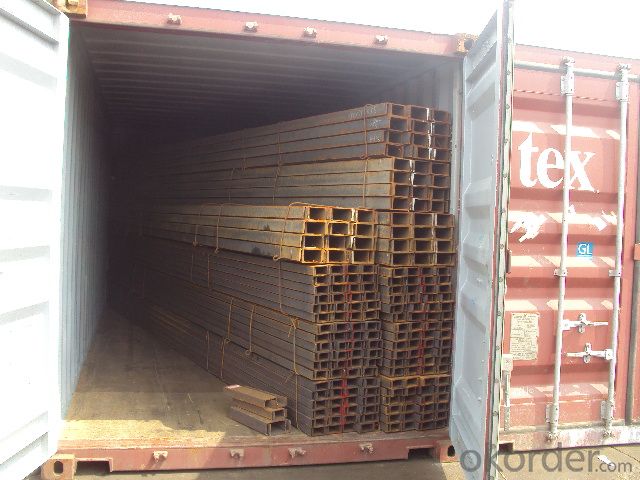
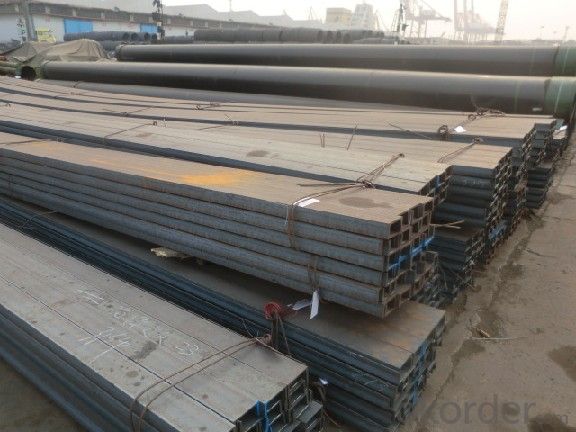
- Q: How do steel channels contribute to natural ventilation?
- Steel channels can contribute to natural ventilation in several ways. Firstly, steel channels can be used to create air vents or openings in buildings. These vents allow fresh air to enter the building and circulate, helping to remove stale air and improve indoor air quality. The channels can be strategically placed to maximize airflow and create a natural flow of air. Additionally, steel channels can be used to create louvers or slats in windows or facades. These louvers allow for adjustable ventilation, allowing occupants to control the amount of air entering the building according to their preference. By adjusting the position of the louvers, the flow of air can be directed towards specific areas or rooms, providing targeted ventilation where it is needed most. Moreover, steel channels can be used to create chimneys or exhaust vents. These structures help to expel hot air, smoke, and other pollutants from the building, promoting a healthier and more comfortable indoor environment. By creating a vertical airflow, the channels help to remove heat build-up and improve air circulation, which is especially beneficial in spaces with high humidity or where odors and contaminants may be present. Overall, steel channels play a crucial role in natural ventilation by providing openings, louvers, and exhaust vents that facilitate the movement of air. By harnessing natural forces such as wind and thermal buoyancy, these channels help to create a sustainable and energy-efficient ventilation system that improves the comfort and well-being of building occupants.
- Q: Can steel channels be used in earthquake-resistant buildings?
- Yes, earthquake-resistant buildings can utilize steel channels. Steel channels are widely utilized in the construction industry due to their durability and high strength. In order to withstand the lateral forces produced during an earthquake, it is imperative to have a structural system that is capable of withstanding such forces. Steel channels are an ideal choice for earthquake-resistant construction as they effectively distribute and dissipate these forces. In earthquake-resistant buildings, steel channels offer numerous advantages. Firstly, they possess exceptional load-bearing capacity, making them capable of supporting heavy loads and resisting the forces exerted during an earthquake. Secondly, they have a high modulus of elasticity, enabling them to deform under stress and then revert to their original shape once the stress is relieved. This flexibility aids in preventing brittle failure and allows the structure to absorb and disperse energy during an earthquake. Moreover, steel channels exhibit high ductility, which is vital in seismic design. Ductility refers to a material's ability to undergo substantial deformations without fracturing. During an earthquake, steel channels can absorb and disperse energy by undergoing plastic deformation, thereby minimizing overall damage to the structure. Furthermore, steel channels offer the advantage of easy fabrication and installation, making them a cost-effective option for earthquake-resistant construction. They are readily available in various sizes and shapes, allowing for design flexibility. Nevertheless, it is important to note that relying solely on steel channels is inadequate to ensure complete earthquake resistance. The overall structural design, including connections, bracing systems, and foundation, should be thoroughly considered and designed by a qualified structural engineer to meet the specific seismic requirements of the region. Building codes and regulations also play a critical role in guaranteeing the safety and resilience of earthquake-resistant buildings.
- Q: Can steel channels be used in outdoor environments?
- Yes, steel channels can be used in outdoor environments. Steel is a durable and weather-resistant material, making it suitable for various outdoor applications such as construction, infrastructure, and outdoor structures. It can withstand harsh weather conditions, including rain, snow, and extreme temperatures, without rusting or deteriorating easily. Additionally, steel channels can be galvanized or coated with protective coatings to enhance their resistance to corrosion and extend their lifespan in outdoor environments.
- Q: Where does channel steel use more? Where does angle iron use more?
- The stainless steel angle can be made up of different stress components according to the different structure, and it can also be used as the connecting piece between the components. Widely used in a variety of architectural and engineering structures, such as beams, bridge [/url], transmission tower, lifting transport machinery, ships, industrial furnace, reaction tower, container rack and warehouse shelves.Stainless steel angle steel is constructed with carbon structural steel. It is a simple section steel. It is mainly used in the frame of metal component and workshop. In use, better weldability, plastic deformation and mechanical strength are required. The raw material for producing stainless steel angle steel is low carbon square billet, the finished product is made of stainless steel and the angle iron is delivered by hot rolling forming, normalizing or hot rolling.
- Q: What are the advantages of using hot-rolled steel channels?
- Some advantages of using hot-rolled steel channels include their high strength-to-weight ratio, durability, and cost-effectiveness. Hot-rolled steel channels are able to support heavy loads while minimizing material weight, making them ideal for structural applications. Additionally, their hot-rolled manufacturing process ensures a consistent and uniform shape, resulting in accurate and easy installation. Furthermore, hot-rolled steel channels are often more affordable compared to other materials, making them a popular choice for various construction projects.
- Q: What are the different loadings that steel channels can withstand?
- Steel channels can withstand a wide range of loadings, making them a versatile and reliable structural component. The specific loadings that steel channels can withstand depend on various factors, including the type and grade of steel, the size and shape of the channel, and the design of the overall structure. Steel channels are commonly used in construction and engineering applications to provide support and stability. They can withstand both static and dynamic loadings, which include dead loads, live loads, and environmental loads. Dead loads refer to the weight of the structure itself, including the weight of the steel channels and any other components or materials. Steel channels are designed to bear this constant load without deformation or failure. Live loads are temporary loads that can vary in magnitude and location. These loads include the weight of people, furniture, equipment, and other transient forces. Steel channels are designed to support these loads and distribute them effectively to other structural members. Environmental loads include wind loads, snow loads, and seismic loads. Steel channels are designed to resist these external forces and maintain the structural integrity of the building or structure. Wind loads can exert significant pressure on the channels, especially on tall or exposed structures. Snow loads can accumulate and add weight to the structure, which the steel channels must be able to support. Seismic loads refer to the forces generated during an earthquake, and steel channels are designed to withstand these dynamic loads and prevent the structure from collapsing. In addition to these common loadings, steel channels can also withstand other specialized loadings, such as impact loads, vibration loads, and thermal loads. Impact loads can occur due to accidental collisions or sudden impact events and require steel channels to have high strength and toughness. Vibration loads can result from machinery or equipment operation and require steel channels to have good fatigue resistance. Thermal loads can cause expansion and contraction of the steel channels due to temperature changes, and they must be designed accordingly to prevent failure. Overall, steel channels have a high load-bearing capacity and can withstand a wide range of loadings, making them suitable for various structural applications in construction, engineering, and industrial sectors.
- Q: Can steel channels be used for fencing systems?
- Steel channels are indeed suitable for fencing systems. Due to their versatility and strength, they prove to be an excellent choice for constructing fences. They lend themselves well to the creation of different types of fences, such as chain link, privacy, or decorative ones. By incorporating steel channels into the fencing system, stability and durability are ensured, enabling it to withstand adverse weather conditions and potential impacts. Moreover, steel channels can be easily customized to accommodate various fence heights and designs. They can be manipulated through welding, cutting, and shaping to meet specific requirements, thus adapting to diverse fencing needs. Ultimately, steel channels offer a dependable and enduring solution for fencing systems.
- Q: Can steel channels be used for overhead crane support?
- Indeed, overhead crane support can be achieved by utilizing steel channels. Renowned for their robustness and endurance, steel channels find frequent application in the realms of construction and engineering. By furnishing an inflexible and steadfast framework, they possess the capability to sustain substantial burdens, rendering them apt for sustaining overhead cranes. It is possible to fashion and install steel channels in diverse arrangements, tailored to the precise prerequisites of the crane system, thereby guaranteeing secure and dependable operation.
- Q: What is the difference between channel steel and angle steel?
- The upper and lower leg channel width is equal, the section is in a groove shape, said channel specification method is based on the height (mm) (mm) * * legs wide waist thickness (mm) in the form of a rectangular section angle is basically the same, on both sides of the thickness and width of steel, steel specifications method is usually in terms of edge width * thick edge.
- Q: Can steel channels be used for support beams?
- Yes, steel channels can be used for support beams. Steel channels are commonly used for structural purposes, including supporting heavy loads. They provide strength, durability, and stability, making them suitable for various construction projects, such as bridges, buildings, and industrial structures.
Send your message to us
Hot Rolled JIS GB Standard Steel Channel
- Loading Port:
- China Main Port
- Payment Terms:
- TT or LC
- Min Order Qty:
- -
- Supply Capability:
- -
OKorder Service Pledge
OKorder Financial Service
Similar products
Hot products
Hot Searches
Related keywords














